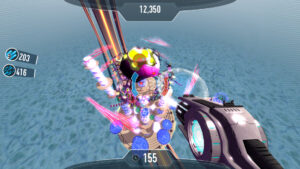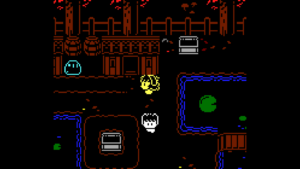Once and Future: True Names
With the hard-bought help of the fairy queen, I’ve only just made it back to Avalon, and can now travel freely between the two realms. So, back to the main quest. But first, let’s reflect briefly on what I’ve come through.
This game was written at a time when Infocom was still the dominant paradigm for IF, which means there are some gratuitous mechanical puzzles, including at one point a Lights Out. Over the years, I’ve come to dislike Lights Out as a pointless waste of time almost as much as Towers of Hanoi, but at least it’s used in a somewhat clever variation here. And anyway, at least the clarity of intent in such puzzles makes it difficult to get truly stuck. I did spend a good few hours stuck on a couple of puzzles in fairyland, but it was always the environmental ones, where it wasn’t obvious what my options were.
The game is full of folkloric and fairy-tale stuff, with a notable repeated motif of Frank being turned into various animals against his will. It seems to be related to the dehumanizing effects of war, particularly in the climax of the Fairyland chapter. There, a masked and antlered being called the Hunter, who had made attempts on your life earlier, decides to keep you as an attack dog instead. And this is notable for a number of reasons. First, it’s the one transformation that you’re capable of actively resisting. Second, it’s one of the few times that the random misadventures tie together, referring back to earlier events — and not just to the earlier murder attack: unmasked, the Hunter turns out to be an elf woman you’d also encountered in a different context. Pieces suddenly come together to form a story, one of someone who can’t bear to be ignored, who will satisfied with being your killer, lover, or master, as long as she’s your something. And the solution, the way to save yourself from her domination? You first have to witness her. To view her life, her story from childhood onward, rather than relating to her purely as an obstacle. It’s only in these flashbacks that you learn her name.
And that makes me think of what I said in my last post about the little girl who Joe killed. Joe is referenced again in this sequence, as one of many whose mortal remains decorate the Hunter’s lair. I’m starting to suspect that sequence may have been subtler than I gave it credit for.
There’s at least one other young girl who needs rescuing: the Oracle back in Avalon, a seven-year-old manacled to a throne, breathing volcanic fumes and giving cryptic hints on a number of topics. I actually broke sequence on this a little inadvertently: in conversations with True Thomas (the fairy queen’s human lover/advisor, who can only speak the truth), Frank references a dialogue with the Oracle on how to free her that I hadn’t actually had yet. When you do free her, there’s a moment when Frank calls her by name, despite him never having learned it — and for once, the game calls him out on it, makes it clear that this slip-up is deliberate. What is going on?
 Comments(0)
Comments(0)
